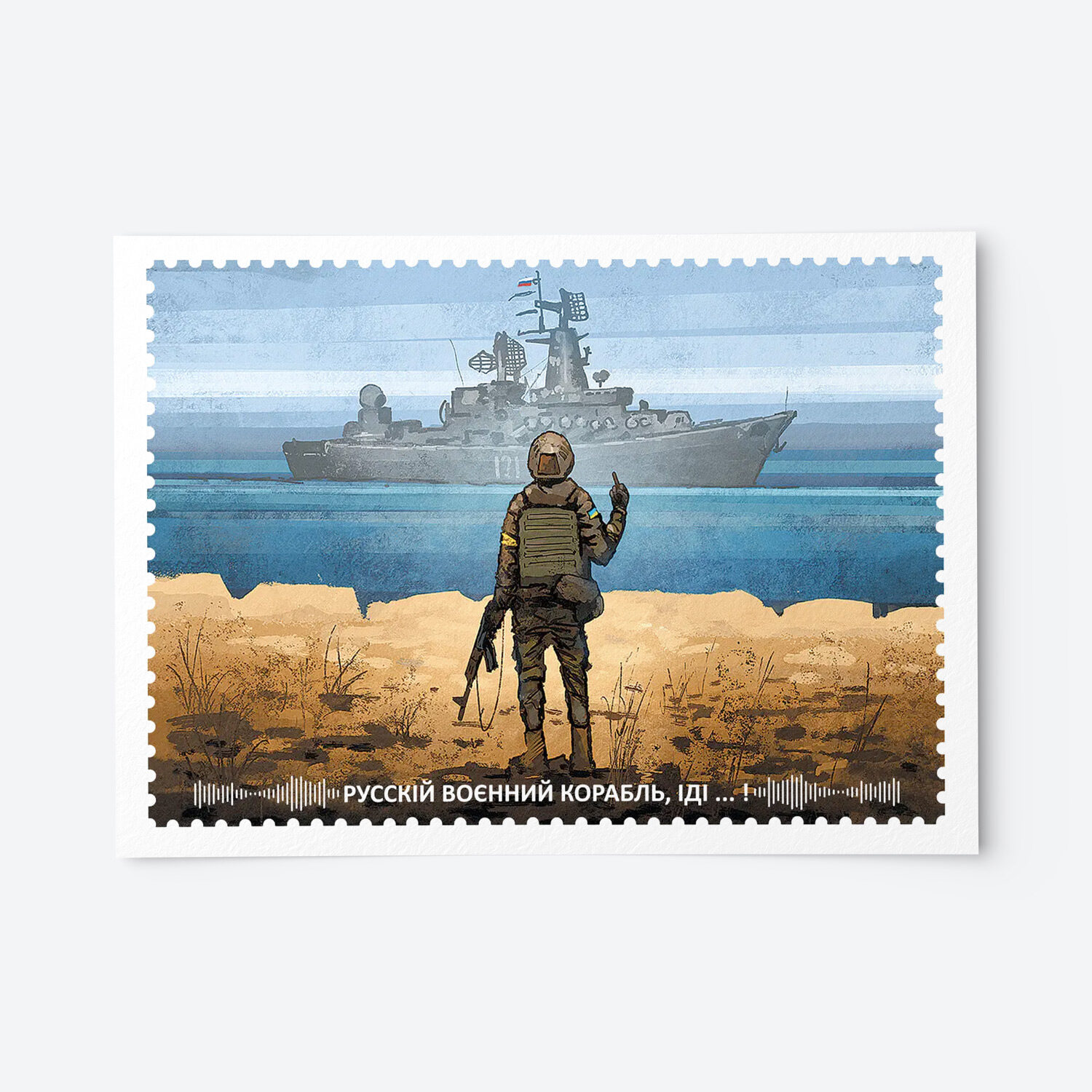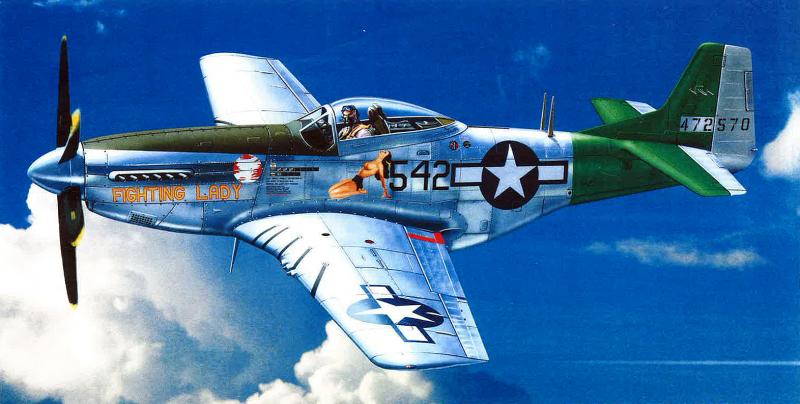Post by Antonio on Mar 27, 2022 12:49:02 GMT 12
This is awesome:
Link: Artist George Butler: ‘I draw what happens at the fringes of atrocity’
Some insight
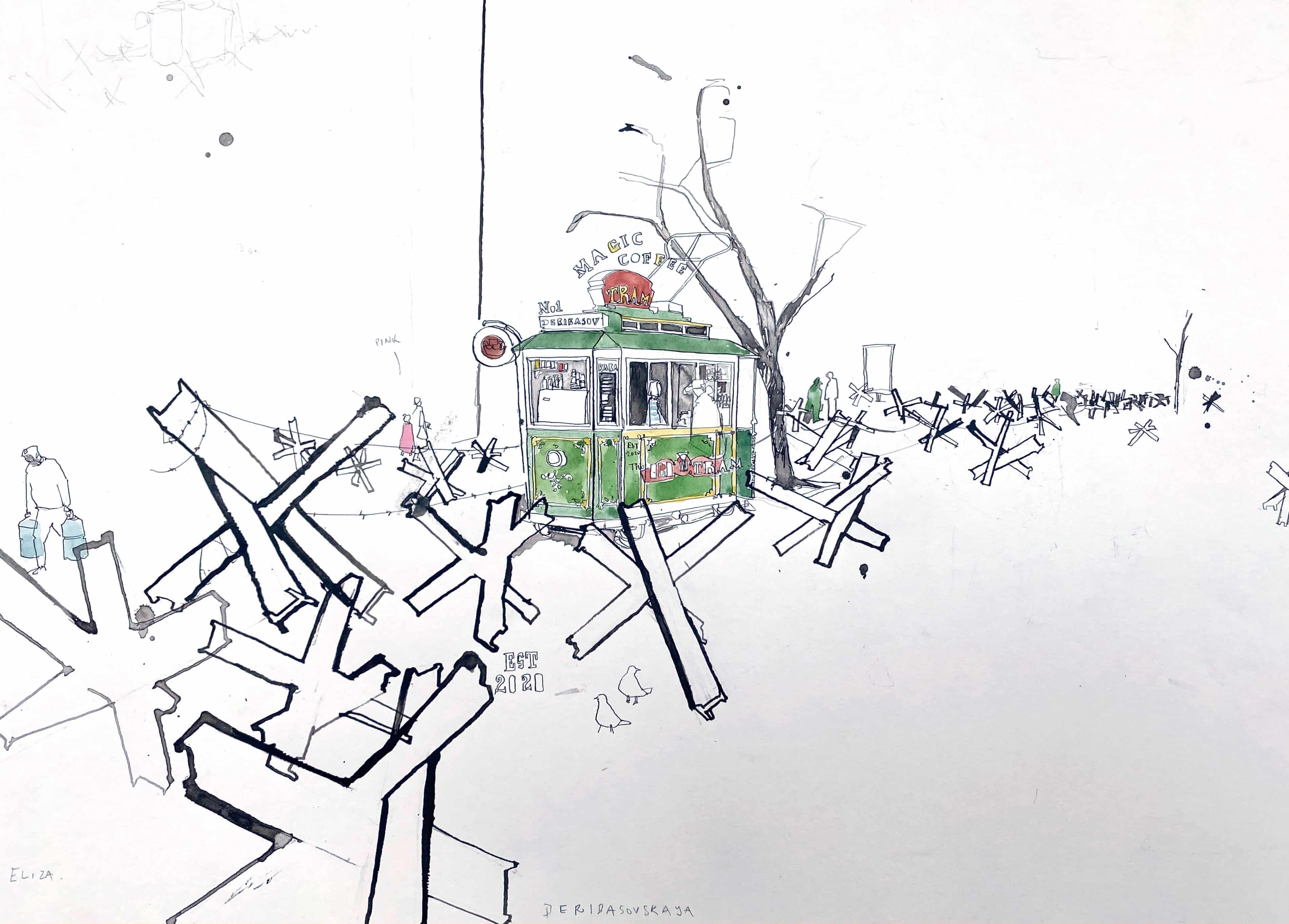
George Butler: ‘This sweet little coffee tram was parked in Odesa. It was run by a girl called Eliza – she must have been about 17. I thought it was extraordinary it was still open for business, but Ukrainians love their coffee. It provides a sense of community as well as caffeine.’
As millions fled the conflict in Ukraine, the reportage illustrator felt compelled to travel there. He explains why he wants to depict the human cost of war
by Lisa O'Kelly, Guardian.
Two weeks into the Russian invasion, as millions of Ukrainians fled their homes and headed west, artist George Butler began his own journey in the opposite direction. Travelling light, his dip pens, watercolours, Indian ink and drawing board stashed in his customary shoulder bag, he took a flight from London to the city of Iasi in Romania, then jumped on a bus to Chișinău, the Moldovan capital. Another long and very crowded bus journey took him to Odesa in southern Ukraine, where he stayed for a few days before continuing on an overnight train to Kyiv, at the heart of the conflict.
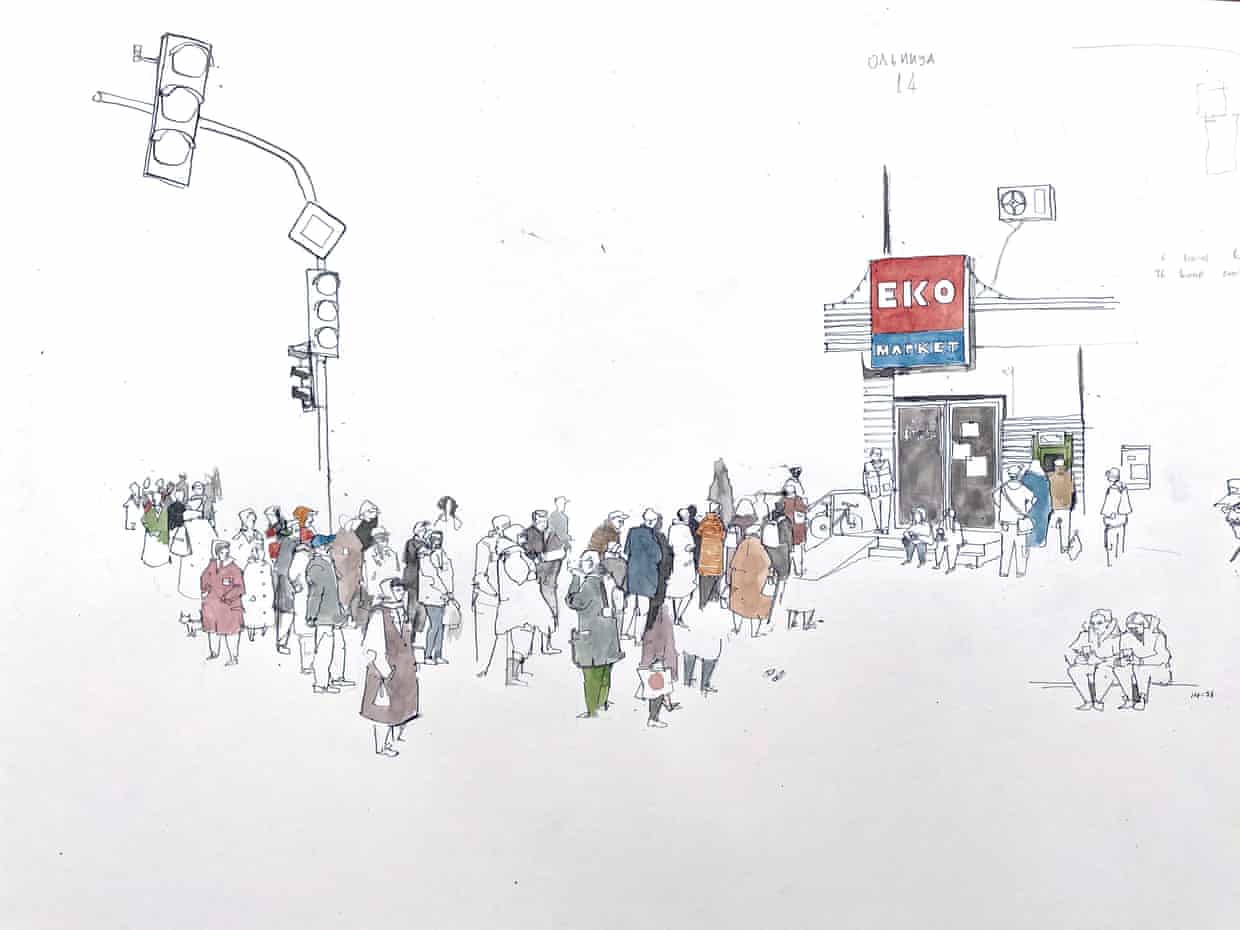
This scene was outside a Kyiv supermarket a few hours before the 36-hour curfew earlier this month. It’s a long queue because everybody was trying to get in as much food as possible before the lockdown. It’s a very typical scene at the moment. You also see long queues at cashpoints that limit people to 200 Ukrainian hryvnia [about £5].’
Talking to him via Signal while he is under curfew in the apartment that has been lent to him by a Kyiv resident, my first question is: why? What made him undertake such a perilous journey into a living nightmare that others are desperate to escape?
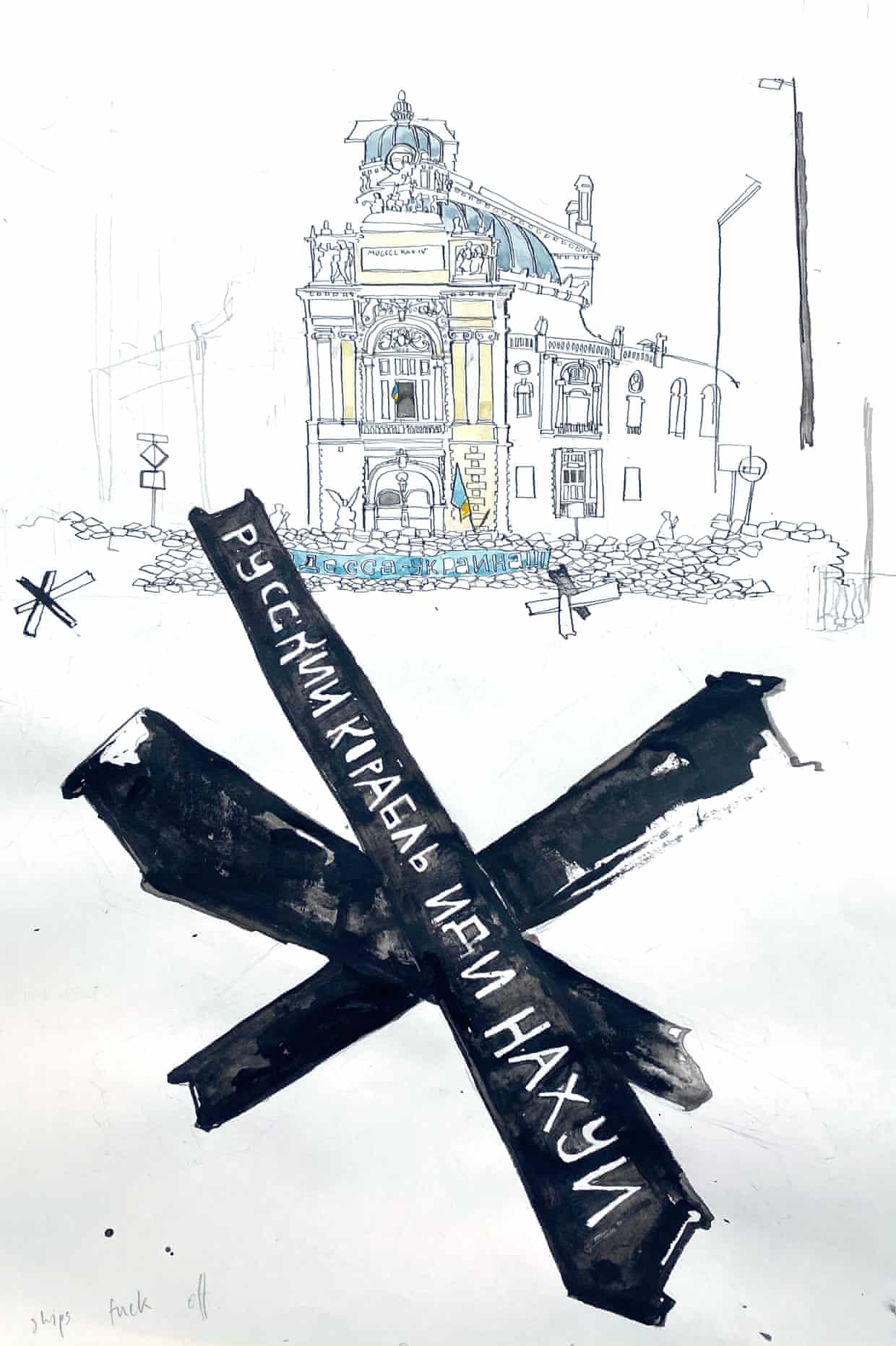
The Opera and Ballet theatre is easily the most beautiful building in Odesa, now surrounded by sandbags and these big black tank hedgehogs that are made by volunteers in factories around the city. They’re cut out of old railway line and put all over the streets and it is impossible for tanks to move through them. Painted or welded on to all of them is the phrase: ‘Russian warship, go f**k yourself.’ That’s become a real slogan. You see it everywhere.’
I guess doing my job is a compulsion,” he says. “I think it’s the same for photojournalists and journalists who cover conflicts. We want to tell stories that otherwise we assume would not be told. That’s always been my intention in Syria, in Afghanistan, in Yemen and all the other places I’ve worked in before.”
Butler has been illustrating what happens in war zones, refugee camps and conflict situations in beautiful, delicate ink and watercolour paintings since he embedded with the British army in Afghanistan at the age of 21. His work has been published in newspapers and magazines all over the world and shown at the Imperial War Museum and the V&A. He dislikes the term ‘“war artist” and prefers to describe himself as a reportage illustrator. “The reality is that I draw what is going on around the margins of war,” he says. “I think there is always space around the edges of these vulnerable, sensitive places to tell longer, slower, quietly observed stories, a visual account of what is going on there. It is not all about tanks and helicopters being blown up – it is about what happens at the fringes of atrocity.”
As Butler waited in Odesa station last week to catch the overnight train to Kyiv, a scene of the kind he is drawn to played out. “The 8pm curfew had begun and it felt eerie in the darkness. Then a man called Volodymyr took out his acoustic guitar and started playing some Ukrainian songs and people began singing along. The guard came along and told him to be quiet but everyone said no, let him play. So he played and his friend handed out flowers, pink tulips, to every woman in the crowd. It was this extraordinary moment.”
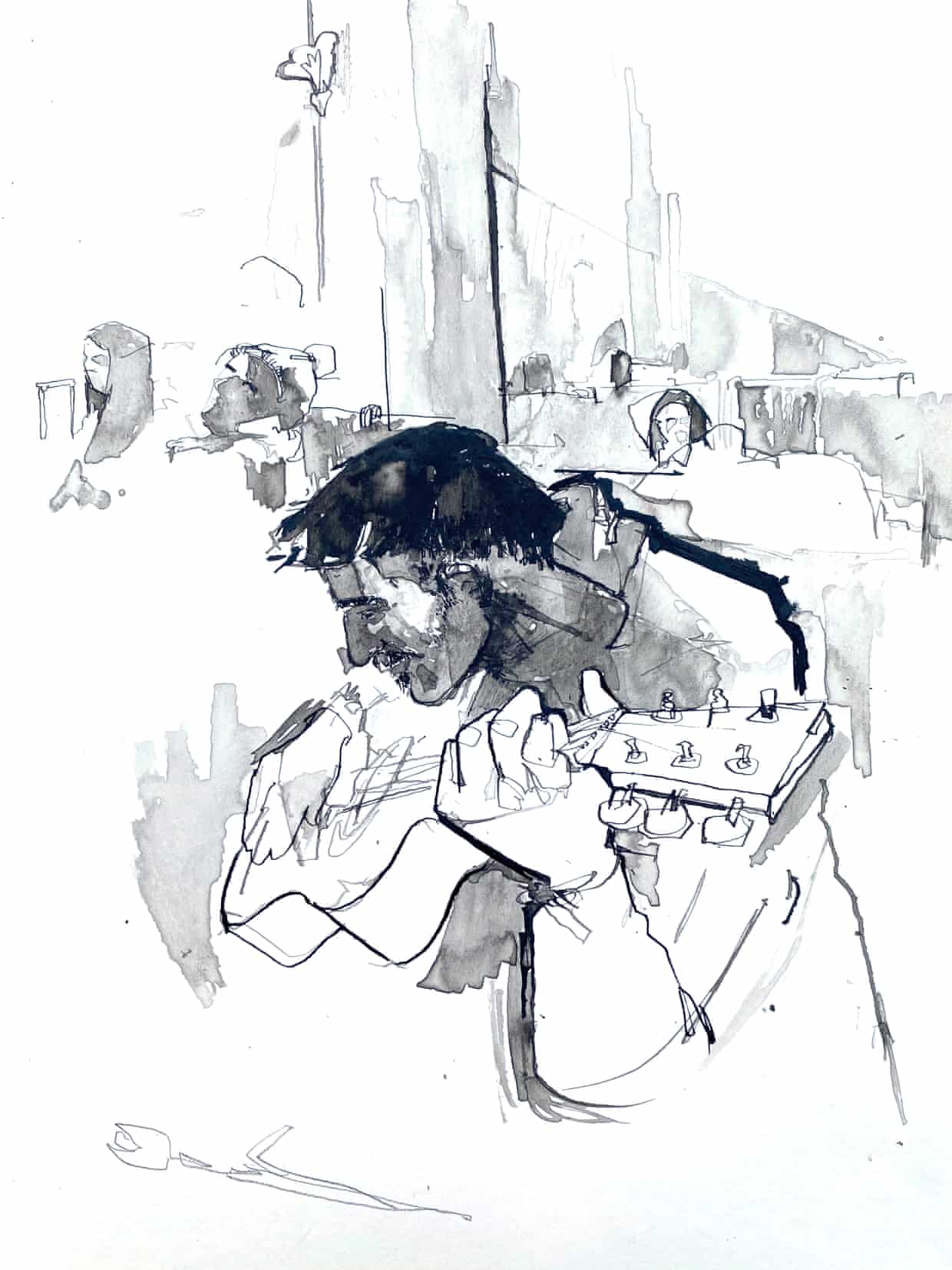
‘Watching and listening to this guitarist in Odesa station, I was struck by the contrast between what was happening in front of me and the fast-moving stuff we’ve seen on our front pages and on TV screens this past few weeks. This was the human element of war, the stuff that happens away from the frontline.’
While Butler has the utmost respect for photographers, he believes that an illustration of the effects of war drawn over a couple of hours offers a different perspective. “It’s not the snap of a shutter and then walking away. You can’t ‘steal’ a drawing. Everything has to be done with the permission of the people in the image. It’s gentle and open. It’s unthreatening.”
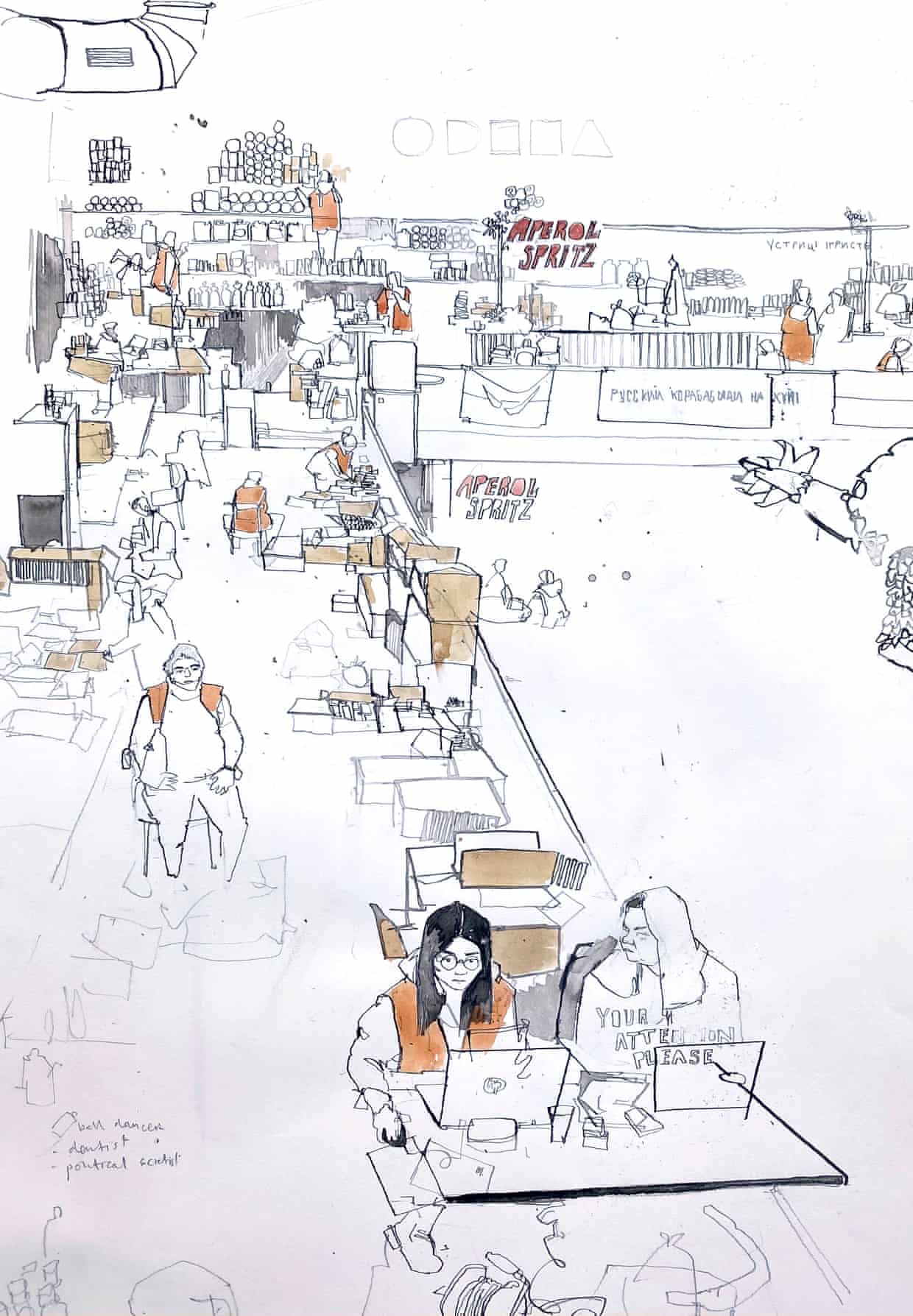
This is the cafe in Odesa food market. It is totally set up for now for hundreds of young volunteers that are coming through and donating their time. A lot of them work in the morning and then come in in the afternoon to help. All those sort of orange hi-vis are all volunteers. They are packing up donations from civilians and from shops and putting them into boxes and sending them to military units, territory defence, across the country.’
Yesterday, in Kyiv, where you can hear thuds of artillery in the background all day, Butler went out with two volunteers, one a human rights lawyer and the other a mother, who were delivering aid to anyone who couldn’t leave their homes. “We visited a woman called Madame Olga. She was 99 and she was terrified of anybody coming into her house because she thought they would be coming to take her away. She wanted to stay in her home, whatever the situation. As I drew her, she told me she was too frail to move down into the bomb shelter when there was an air raid so she and her daughter just stayed in the flat and hoped that any bombs would miss. That is the civilian cost of what is going on. Madame Olga is not at war, but war is very much part of her life.
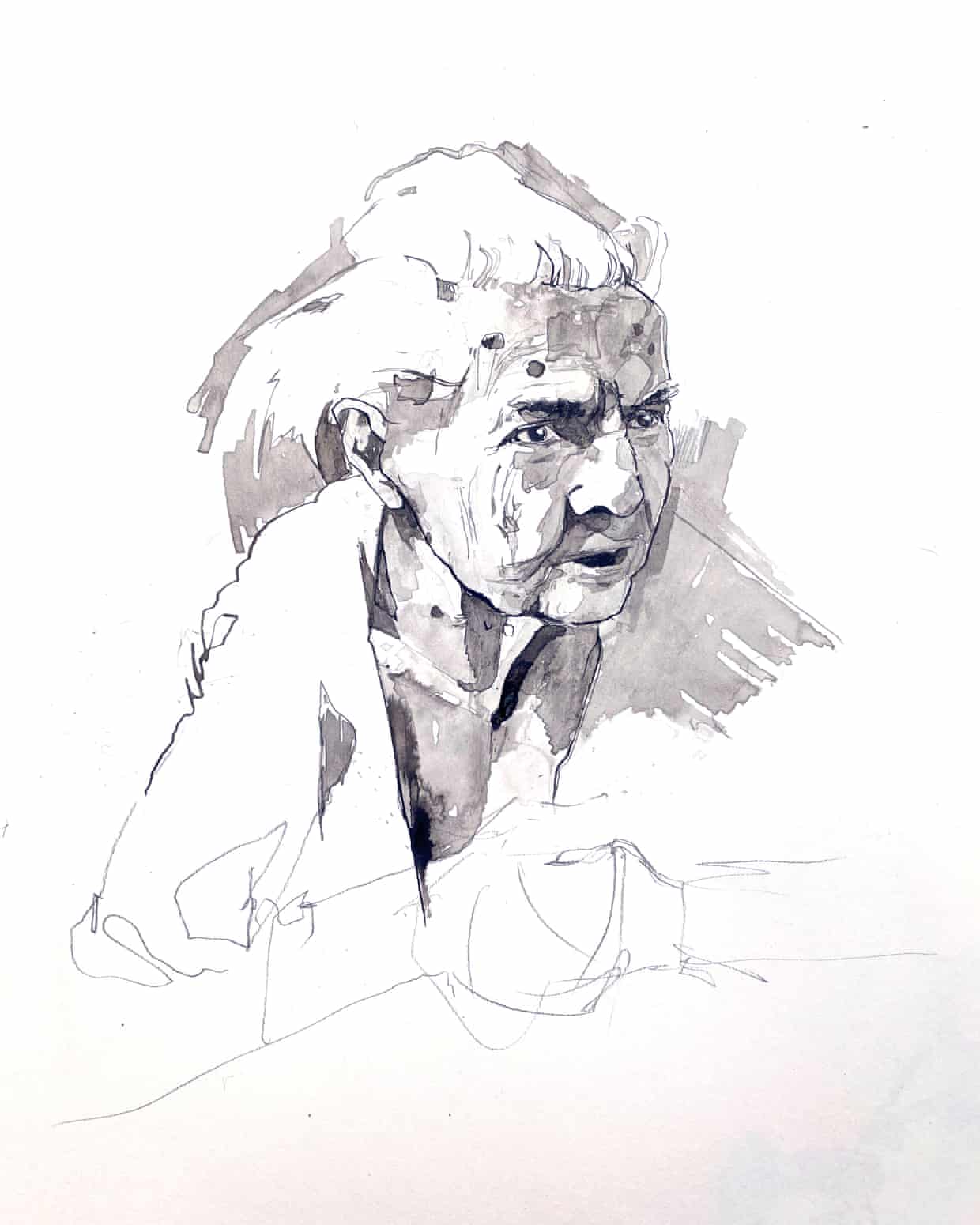
‘This is Madame Olga, 99. She is almost completely blind and deaf, She doesn’t want to leave her flat so she stays there through the air raids with her daughter, 79, hoping the missiles will not find them.’
“She’s 100 in August and she invited us to her birthday. She lived through the Great Famine – the Holodomor – and the second world war and now she is going through this. She told me she is so worried that she forgets the words to describe how she feels. The anxiety is so great she can’t explain it. It was very moving and I think that is an example of a drawing being a gentle way into sitting with someone and listening to what they’re saying. That’s not to say it can’t be done with a camera, but I hope that drawings offer a different dimension.”
George Butler’s work in Ukraine is part-funded by the Pulitzer Centre for Crisis Reporting
Drawn Across Borders: True Stories of Migration by George Butler is published by Walker Studio (£15). To support the Guardian and Observer order your copy at guardianbookshop.com. Delivery charges may apply
Link: Artist George Butler: ‘I draw what happens at the fringes of atrocity’
Some insight

George Butler: ‘This sweet little coffee tram was parked in Odesa. It was run by a girl called Eliza – she must have been about 17. I thought it was extraordinary it was still open for business, but Ukrainians love their coffee. It provides a sense of community as well as caffeine.’
As millions fled the conflict in Ukraine, the reportage illustrator felt compelled to travel there. He explains why he wants to depict the human cost of war
by Lisa O'Kelly, Guardian.
Two weeks into the Russian invasion, as millions of Ukrainians fled their homes and headed west, artist George Butler began his own journey in the opposite direction. Travelling light, his dip pens, watercolours, Indian ink and drawing board stashed in his customary shoulder bag, he took a flight from London to the city of Iasi in Romania, then jumped on a bus to Chișinău, the Moldovan capital. Another long and very crowded bus journey took him to Odesa in southern Ukraine, where he stayed for a few days before continuing on an overnight train to Kyiv, at the heart of the conflict.

This scene was outside a Kyiv supermarket a few hours before the 36-hour curfew earlier this month. It’s a long queue because everybody was trying to get in as much food as possible before the lockdown. It’s a very typical scene at the moment. You also see long queues at cashpoints that limit people to 200 Ukrainian hryvnia [about £5].’
Talking to him via Signal while he is under curfew in the apartment that has been lent to him by a Kyiv resident, my first question is: why? What made him undertake such a perilous journey into a living nightmare that others are desperate to escape?

The Opera and Ballet theatre is easily the most beautiful building in Odesa, now surrounded by sandbags and these big black tank hedgehogs that are made by volunteers in factories around the city. They’re cut out of old railway line and put all over the streets and it is impossible for tanks to move through them. Painted or welded on to all of them is the phrase: ‘Russian warship, go f**k yourself.’ That’s become a real slogan. You see it everywhere.’
I guess doing my job is a compulsion,” he says. “I think it’s the same for photojournalists and journalists who cover conflicts. We want to tell stories that otherwise we assume would not be told. That’s always been my intention in Syria, in Afghanistan, in Yemen and all the other places I’ve worked in before.”
Butler has been illustrating what happens in war zones, refugee camps and conflict situations in beautiful, delicate ink and watercolour paintings since he embedded with the British army in Afghanistan at the age of 21. His work has been published in newspapers and magazines all over the world and shown at the Imperial War Museum and the V&A. He dislikes the term ‘“war artist” and prefers to describe himself as a reportage illustrator. “The reality is that I draw what is going on around the margins of war,” he says. “I think there is always space around the edges of these vulnerable, sensitive places to tell longer, slower, quietly observed stories, a visual account of what is going on there. It is not all about tanks and helicopters being blown up – it is about what happens at the fringes of atrocity.”
As Butler waited in Odesa station last week to catch the overnight train to Kyiv, a scene of the kind he is drawn to played out. “The 8pm curfew had begun and it felt eerie in the darkness. Then a man called Volodymyr took out his acoustic guitar and started playing some Ukrainian songs and people began singing along. The guard came along and told him to be quiet but everyone said no, let him play. So he played and his friend handed out flowers, pink tulips, to every woman in the crowd. It was this extraordinary moment.”

‘Watching and listening to this guitarist in Odesa station, I was struck by the contrast between what was happening in front of me and the fast-moving stuff we’ve seen on our front pages and on TV screens this past few weeks. This was the human element of war, the stuff that happens away from the frontline.’
While Butler has the utmost respect for photographers, he believes that an illustration of the effects of war drawn over a couple of hours offers a different perspective. “It’s not the snap of a shutter and then walking away. You can’t ‘steal’ a drawing. Everything has to be done with the permission of the people in the image. It’s gentle and open. It’s unthreatening.”

This is the cafe in Odesa food market. It is totally set up for now for hundreds of young volunteers that are coming through and donating their time. A lot of them work in the morning and then come in in the afternoon to help. All those sort of orange hi-vis are all volunteers. They are packing up donations from civilians and from shops and putting them into boxes and sending them to military units, territory defence, across the country.’
Yesterday, in Kyiv, where you can hear thuds of artillery in the background all day, Butler went out with two volunteers, one a human rights lawyer and the other a mother, who were delivering aid to anyone who couldn’t leave their homes. “We visited a woman called Madame Olga. She was 99 and she was terrified of anybody coming into her house because she thought they would be coming to take her away. She wanted to stay in her home, whatever the situation. As I drew her, she told me she was too frail to move down into the bomb shelter when there was an air raid so she and her daughter just stayed in the flat and hoped that any bombs would miss. That is the civilian cost of what is going on. Madame Olga is not at war, but war is very much part of her life.

‘This is Madame Olga, 99. She is almost completely blind and deaf, She doesn’t want to leave her flat so she stays there through the air raids with her daughter, 79, hoping the missiles will not find them.’
“She’s 100 in August and she invited us to her birthday. She lived through the Great Famine – the Holodomor – and the second world war and now she is going through this. She told me she is so worried that she forgets the words to describe how she feels. The anxiety is so great she can’t explain it. It was very moving and I think that is an example of a drawing being a gentle way into sitting with someone and listening to what they’re saying. That’s not to say it can’t be done with a camera, but I hope that drawings offer a different dimension.”
George Butler’s work in Ukraine is part-funded by the Pulitzer Centre for Crisis Reporting
Drawn Across Borders: True Stories of Migration by George Butler is published by Walker Studio (£15). To support the Guardian and Observer order your copy at guardianbookshop.com. Delivery charges may apply



